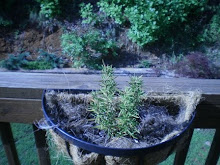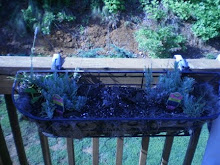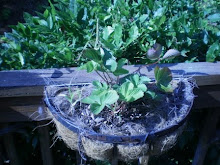Here is a quick glance at a few Aromatherapy Herbs and what they contribute when used.

CHAMOMILE: also known as German chamomile and Roman chamomile ~
PARTS USED: Flowers ~ Contains: Volatile oil, flavonoids, coumarins, plant acids, fatty acids, cyanogenic glycosides, salicylate derivatives, choline, tannin. KEY USES: Relaxant, antispasmodic, anti inflammatory, bitter tonic, antiseptic, diaphoretic, kiuretic, analgesic, antihistamine, decongestant.
This herb is a wonderful relaxant for the nervous system and digestion. A perfect remedy for babies and children. *note* I would make my boys Chamomile tea in the evenings to relax them and when they were not feeling well. ~ It helps to relax muscles throughout the body. In the digestive tract it relieves tension , spasm, colic, and abdominal pain. It is also known to help with migraines, toothaches, earache, cramps, etc. (for more info, read: The Complete Woman's Herbal by Anne Mcintyre pg 41)
CINNAMON: also known as Cinnamomum zeylanicum, Cinnamomum verum, Batavia Cassia, Batavia Cinnamon, Cannelier de Ceylan, Cannelle de Ceylan, Cannelle de Saïgon, Cannelle du Sri Lanka, Ceylon Cinnamon, Ceylozimt, Ceylozimtbaum , Corteza de Canela, Dalchini, Ecorce de Cannelle, Laurus cinnamomum, Madagascar Cinnamon, Padang-Cassia, Panang Cinnamon, Saigon Cassia, Saigon Cinnamon, Sri Lanka Cinnamon, Thwak, Tvak
PARTS USED: bark and the leaves ~ Uses: Hay-fever, Yeast Infection, Irritable Bowel Syndrome, Salmonella Infection (food poisoning), Diabetes (lowers blood sugar), Diarrhea, Worm Infestations, Common Cold Influenza, Flatulence (gas), Spasms, Appetite Stimulation and Menstrual Discomfort, * Note, avoid in early pregnancy.
Cinnamon Leaf Oil is the type of oil used in aromatherapy, has a very high concentration of cinnamic aldehyde which is a powerful skin irritant. This oil should NOT be used in aromatherapy. Instead, use in an aroma lamp or diffuser. It is an extremely strong antibacterial and antifungal oil, helps to clean the air in ones home during the winter months. When inhaled, it serves as a respiratory and circulatory stimulant and antiseptic (for more info, read: Cinnamon Leaf Essential Oil - Good Information & History )
Cinnamon Leaf Oil is the type of oil used in aromatherapy, has a very high concentration of cinnamic aldehyde which is a powerful skin irritant. This oil should NOT be used in aromatherapy. Instead, use in an aroma lamp or diffuser. It is an extremely strong antibacterial and antifungal oil, helps to clean the air in ones home during the winter months. When inhaled, it serves as a respiratory and circulatory stimulant and antiseptic (for more info, read: Cinnamon Leaf Essential Oil - Good Information & History )
YARROW: also known as Achillea millefolium or Nosebleed, millefoil ~
PARTS USED: flower, aerial parts ~ Contains: volatile oil, coumarins, lactones, amino acids, sterols, bitters, flavonoids, tannins, saponins, salicylic acid, sugars, cyanidin. Uses: astringent, vulnerary, anti- inflammatory, antiseptic, diurectic. Taken hot, yarrow is excellent for helping to throw off fevers and infections such as colds, flu, coughs and sore throats. In the digestive system, yarrow stimulates the appetite, enhances digestion and absorption. the diuretic action aids the elimination of fluid and toxins from the system via the urine. It also contains a hormone like action which may help to regulate the menstrual cycle. ( for more info, read: The Complete Woman's Herbal by Anne Mcintyre pg 213 here are two websites to read more on benefits, cautions, etc: ( Elements Natural Therapy or Oil Health Benefits ~ Yarrow )
SPEARMINT: also known as Mentha spicia (Easy to Grow)
PARTS USED: Flowers, buds and stems ~ Contains: a few things, however the main components include alpha-pinene, beta-pinen, cavone, cineole, caryophyllene, linalool, limonene, menthol and myrcene. Uses: Antifungal, Antioxidant, Aromatic, Astringent, Carminative, Diuretic, Expectorant, Insect Repellent, Stimulant. It helps to break up congestion while lifting the spirits, also helpful to energize the mind and body. *Note* Spearmint should not be used undiluted. FYI, most spearmint essential oils do not contain as much menthol as peppermint oil. For more information/good read (Mercola - Article on Spearmint Oil) or (The Complete Book of Essential Oils) (Mojito-Recipe-Using-Fresh-Mint)
LAVENDER: also known as Lavendula officinalis
PARTS USED: Flowers, Blooms & Stems ~ Contains: Volatile oil, tannins, coumarins, flavonoids, triterpernoids. Uses: Relaxant, antispasmodic, expectorant, detoxifying, antidepressant, nerve tonic, antiseptic, diaphorectic, decongestant, rubefacient. Lavender is one of my all time favorite essential oils, for its many, many health and healing properties. It has been one of the most used and loved fragrances of all time. Just inhaling the scent has a relaxing effect on the mind and body. It helps with anxiety and nervousness. Lavender oil is considered a balancer for our emotions. Taken as hot tea, lavender causes sweating and reduces fevers. It also aids in detoxing the body by increasing elimination of toxins via the skin and via urine, as it is a mild diuretic.
It has healing properties for external cuts and wounds, also sores and ulcers - because of the disinfectant properties it contains. It will stimulate tissue to help repair and minimize scaring. Always test on a small area to see if you need to dilute before applying to skin (use almond or grape seed oil)
Lavender oil is an ideal "First-Aid Essential Oil" to have at home.......as is Tea Tree Oil.
For more information/good read (wikipedia Lavandula_angustifolia) (University of Maryland Medical Center)
PEPPERMINT: also known as Mentha piperita
PARTS USED: Leaves & Stems - Contains: Volatile oil, carotenoids, betaine, choline, flavonoids, phytol, tocopherols, azulenes, rosmarinic acid, tannin ~ Uses: Carminative, Antispasmodic,Decongestant, Anti-emetic, Diaphoretic, Tonic. Peppermint is both cooling and warming. When you drink as a tea it induces the body's heat, while improving circulation. It does this by dispersing blood to the surface of the body to cause sweating. This makes it a perfect tonic for chills, fevers, flu and colds. Because of the decongestant and astringent properties it helps to relieve stuffiness. The refreshing taste of mint is followed by a cooling and numbing effect which extends to the respiratory tract.
For more information/good read (The Power of Peppermint) (Peppermint-Health-Potential)
VALERIAN: also known as Valeriana officinalis, Caprifoliaceae
PARTS USED: Roots; Flowers - Contains: Alkaloids, Isovaleramide, Gamma-aminobutyric acid, Isovaleric acid, Iridoids and Flavanones ~ Uses: Medicinal herb since the time of ancient Greece and Rome as a sedative, antiseptic, anti-convulsant, migraine treatment, and pain reliever.
For more information/good read (Cancer Treatments) (Mountain Rose Herbs)
LEMONGRASS: also known as Andropogon citratus, Andropogon flexuosus, Capim-Cidrao, Ceylon Citronella Grass, or Cymbopogon citratus
PARTS USED: Stems, Leaves & Buds - Contains: a chemical component called citral or lemonal, an aldehyde responsible for the unique lemon smell. Citral also has a strong anti-microbial and anti-fungal property. Also contains other constituents of essential oils such as: myrcene, citronellol, methyl heptenone, dipentene, geraniol, limonene, geranyl acetate, nerol and more. It is said these compounds are known to have counter=irritant, rubefacient, insecticidal, anti-fungal and anti-septic properties.
USES: treating digestive tract, stomach ache, (?) high blood pressure (still studying effects on) convulsions, pain, vomiting, cough, achy joints, fever, colds and exhaustion. Also used to kill germs and can be used as a mild astringent. Applying the essential oil directly to skin or inhaling vapors for headaches, abdominal pain and muscle pain.
Updating Soon: WHITE WILLOW, FLAX SEED, ROSEMARY AND YELLOW DOCK
Quick Definition of Words Used:
Volatile Oil is "oil of" the plant from which they were extracted.
Flavonoids are highly diversified plant pigments that are present in a wide range of fruits, vegetables, nuts, and beverages. They are regularly consumed in the human diet and have various biological activities including anti-inflammatory, anti-cancer, and anti-viral properties. The flavonoids maybe one of the safest non-immunogenic drugs because they are small organic compounds which have been normally absorbed by the human body for long time. During the past decades, the patents on their health effects have inflated very much and the yearly number of the patents is on an increasing trend.
Coumarins are a fragrant crystalline compound C9H6O2 used chiefly in soaps and perfumery
Cyanogenic Glycosides are the products of secondary metabolism, to the natural products of plants. These compounds are composed of an α-hydroxynitrile type aglycone and of a sugar moiety (mostlyd-glucose). The distribution of the cyanogenic glycosides (CGs) in the plant kingdom is relatively wide, the number of CG-containing taxa is at least 2500, and a lot of such taxa belong to families Fabaceae, Rosaceae, Linaceae, Compositae and others.

























No comments:
Post a Comment